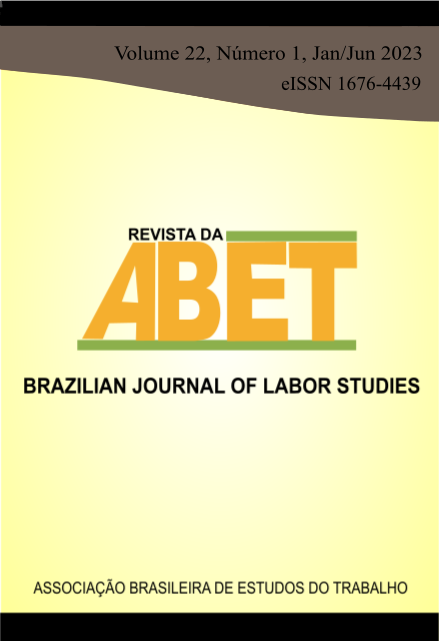WHO ARE YOUNG PEOPLE ‘NEET’ IN THE METROPOLITAN REGION OF FORTALEZA
DOI:
https://doi.org/10.61999/abet.1676-4439.2023v22n1.53125Abstract
This study aims to outline the socio-demographic profile of young people neet, even those who live in the Metropolitan Region of Fortaleza (RMF), in addition to estimating the probability of being in this condition. PNAD 2015 microdata is the main source of information. As for the results, the most striking characteristics in the profile of the young people neet, from 15 to 29 years old, is the predominance of women, of mixed race/color, with complete high school or incomplete higher education, single, lives with their parents, in an urban area and in households with income up to ½ minimum wage. The probit model showed that only schooling negatively affects the probability of being in this condition, while the other variables have a 'positive' effect, by increasing the chance of being neet, with emphasis on per capita family income below half the minimum wage, explanatory variable with the greatest impact, reaffirming the financial vulnerability of young people who are in such condition.
Downloads
Metrics
Downloads
Published
How to Cite
Issue
Section
License
Copyright (c) 2023 Antonia Jaine da Silva Pereira e Silvana Nunes de Queiroz

This work is licensed under a Creative Commons Attribution-NonCommercial-NoDerivatives 4.0 International License.
Política de Acesso Livre
Esta revista oferece acesso livre imediato ao seu conteúdo, seguindo o princípio de que disponibilizar gratuitamente o conhecimento científico ao público proporciona maior democratização mundial do conhecimento.
Atribuição dos artigos é não comercial (sem derivações 4.0, isto é, Creative Commons) e o acesso é livre e gratuito para download e leitura.
Não há taxa para submissão, avaliação e publicação de artigos.
Copyright
1) Os artigos são de responsabilidade exclusiva dos autores. É permitida sua reprodução, total ou parcial desde que seja citada a fonte.
2) Os trabalhos enviados para publicação devem ser inéditos, não sendo permitida sua apresentação simultânea em outro periódico nacional.
3) Os artigos são submetidos a pareceristas "ad hoc", após prévia avaliação da Comissão Editorial, os quais podem aceitar, recusar ou reapresentar o original ao autor com sugestões para alterações. Os nomes dos pareceristas permanecem em sigilo, bem como os nomes dos autores.
Os Autores que publicam nesta revista concordam com os seguintes termos:
Autores mantêm os direitos autorais e concedem à revista o direito de primeira publicação, com o trabalho simultaneamente licenciado sob a Creative Commons Attribution License, permitindo o compartilhamento do trabalho com reconhecimento da autoria do trabalho e publicação inicial nesta revista.
Autores têm autorização para assumir contratos adicionais separadamente, para distribuição não-exclusiva da versão do trabalho publicada nesta revista (ex.: publicar em repositório institucional ou como capítulo de livro), com reconhecimento de autoria e publicação inicial nesta revista.
Autores têm permissão e são estimulados a publicar e distribuir seu trabalho online (ex.: em repositórios institucionais ou na sua página pessoal), já que isso pode gerar alterações produtivas, bem como aumentar o impacto e a citação do trabalho publicado.
Patrocinador
A publicação recebe financiamento da Associação Brasileira de Estudos do Trabalho.










